Navigating Short Reports
Setting the Stage
At their core, short reports are research documents typically authored by institutions or individuals who expect to profit from the decline in the target’s stock price. Their fundamental aim is to present an argument as to why a company may be overvalued, which can include discussions around traditional valuation metrics and financial statement forensics all the way down through misrepresented facts, ethical issues, or even outright fraud.
However, it is important for companies and their stakeholders to differentiate between a speculative or malicious short report and one that is well-researched. Superficial or misleading reports may aim to create panic, manipulative stock prices, or serve ulterior motives, while a thorough short report can actually serve the market by identifying genuine concerns and prompting companies to responsibly address them.
The State of Short Reports
It was a busy past decade for short report activity. In the nine years between 2014 and 2022, there were about 182 global activist short reports generated annually on average; and in every year during this time period, these short reports were effective in producing a desired outcome, generating positive mid-single-digit one-week returns on average.
It is also interesting that during this same time period, the trendline in the number of reports produced each year is down, culminating with 2022, which was the first year in where the number of short reports fell below 100.
The dip in 2022 was likely a function of increased bear market sentiment and difficult economic conditions, which drove down stock prices more broadly and significantly on their own.
Another explanation for this broader trend may be increased scrutiny. As an example, toward the beginning of 2022, reports indicated that the Department of Justice had fully launched an investigation into the tactics employed by short sellers. Numerous activist short sellers were said to be under scrutiny, notably including Citron Research and Muddy Waters, led by Andrew Left and Carson Block, respectively.
That said, activist short sellers that did launch campaigns during 2022 clocked in their most profitable one-week returns of any year during this period, suggesting these firms may have been acting with more discernment (and accuracy) amidst the federal probe.
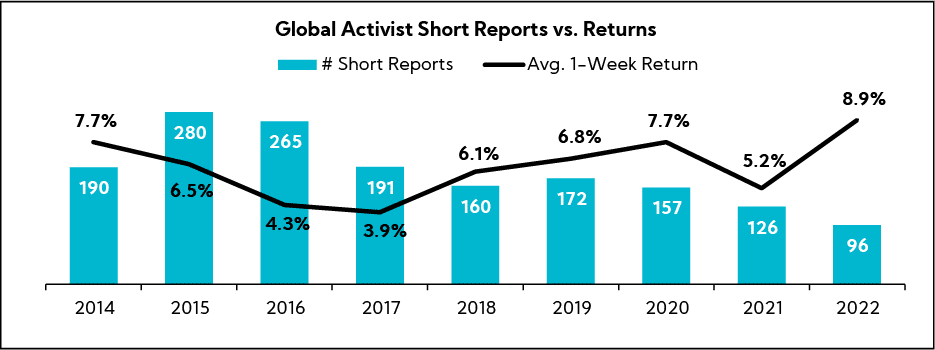
To Respond or Not to Respond?
An Analysis of Recent Short Reports
Another layer of complexity for companies targeted by a short report is deciding whether or not to respond publicly to its assumptions or allegations. Do attempts at damage control actually work, or is it better to say nothing?
In order to glean additional insights into current short report trends, our Research Center of Excellence analyzed 45 short reports that have been issued between 2022 and 2023, across market caps and sectors, to identify if and how the targeted companies responded to activist allegations. Additionally, we analyzed the associated stock price reactions following the release of the short report, broken down by company action.
The sector breakdown of the analyzed reports are as follows:
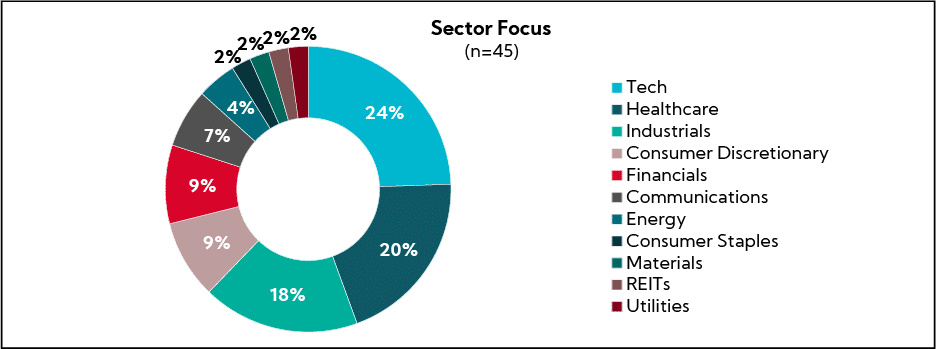
Key Findings

Trading Volume
On average, short report publications resulted in an average daily trading volume spike of 217% versus the day prior, and it took at least one week after the release for trading activity to return to relatively normal levels
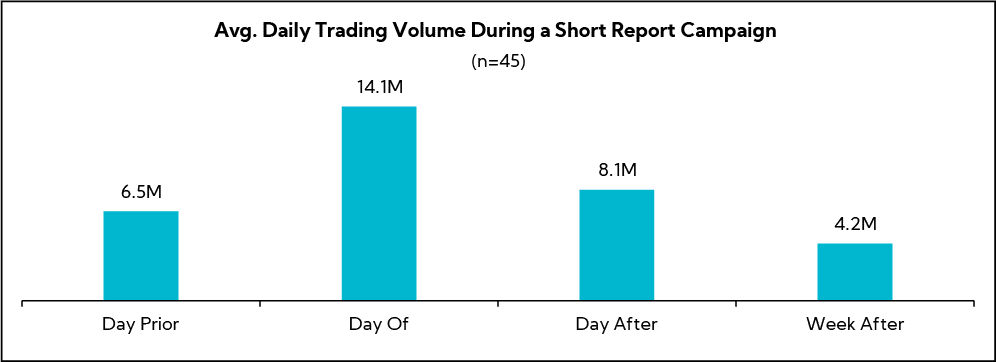

Response Types
Following the release of the report, we grouped target company responses into three categories and tracked their associated stock price reactions:
- Immediate Response (16%): Target companies who issued responses on the same day as the published short report; these companies were associated with a significant (27.0%) day of decrease, on average
- Delayed Response (16%): Target companies who issued responses at least one day (average was 3 days) following a published short report; these companies were associated with a modest decline of (2.2%) the day of the short report release, but a larger 7-day decline of (12.5%), on average
- No Response (68%): Target companies who chose not to issue any direct response to the short report; these companies were associated with a decline of (3.4%) the day of the short report release, and a modest 90-day decline (0.8%)

To visually depict the disparity among these groups, we indexed the price performances in the chart below over a 90-day period following publication of the short report
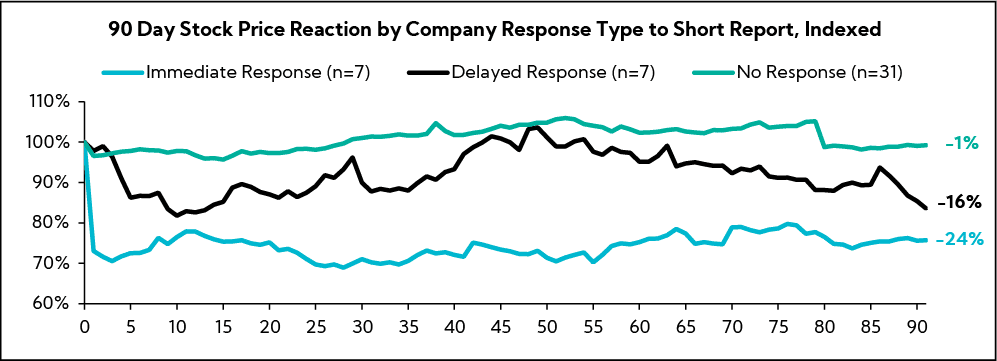

Delivery Mechanism
In terms of how companies delivered their responses, 100% of companies elected to issue a separate press release and 14% supplementally addressed the short report within earnings prepared remarks

Response Content
In general, responses were short and concise, including the following characteristics:
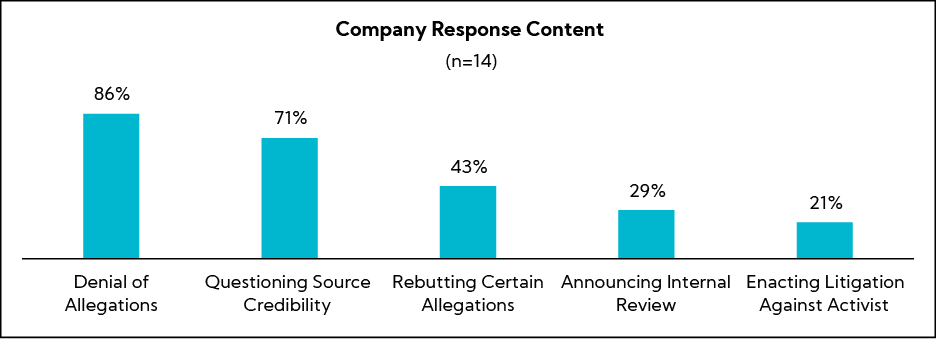
Interestingly, recent academic literature1 indicates companies are more likely to respond when reports contain new data points not already available in public filings. This phenomenon suggests it is easier for a company to refute new information presented by an activist than to respond to differences in opinion grounded in existing public filings.
Not all Short Reports are Created Equal
While we have quantitatively evaluated past stock price reactions to different short report strategies, there can be subjective factors that come into play in the decision tree of whether and when to respond.
In determining the level of concern, a short report should elicit, companies need to consider the credibility of the source, potential underlying motivations behind the report, contextual timing, and, of course, the market’s reaction.
The most important factors to consider include:
- Severity of Accusations
- Level of Public Awareness
- Potential Business Impacts
- Strength of Evidence
Below, we have outlined the various levels of each factor and placed them into a decision matrix. In general, reports that fall into two or more “High / Strong” buckets may call for a public response from the company in an effort reign in the message.
Considerations
Severity of Accusations
Low
Minor inaccuracies or misrepresentations that don’t materially affect the company’s core operations or financials; may be based on poor analysis or lack of company understanding
Medium
Claims that could raise questions about certain business practices, ethics, or management decisions; while these don’t imply major misconduct, they could result in discussions that require clarification from the Street
High
Serious accusations that imply financial irregularities, regulatory violations, or major operational flaws; if true, these claims could lead to significant business disruptions, legal, or regulatory actions
Level of Public Awareness
Low
Limited mainstream media coverage, not trending on social media, no immediate calls for official responses or clarifications
Medium
Some mainstream media coverage, related discussions among stakeholders that are coming back to the IRO / business leaders
High
Front page of the Wall Street Journal or other major news business media, trending on social platforms, frequently mentioned in investor communications where the narrative is incorrectly becoming widely accepted (or has the potential to be)
Potential Business Impact
Low
Little impact on stock price, revenues, or partnerships; likely to be negligible or dismissed by major stakeholders in the short term
Medium
Could lead to some lost partnerships or customer trust; may lead to short- term financial implications or need for damage control
High
Significant potential for lasting damage to the stock price, revenue streams, customer or vendor relationships, or reputation of products, services, or overall brand Strength of Evidence
Strength of Evidence
Weak
Accusations lack solid evidence or rely heavily on speculation / anecdotal evidence
Neutral
Some evidence provided, but may have gaps, inconsistencies, or areas that require further investigation; accusations may not paint the complete picture
Strong
Strong Accusations are backed by compelling, hard evidence; data is well- researched, and the claims are coherent and relevant

When advising our clients in the aftermath of a short report, our approach will always be customized and vary on a case-by-case basis. That said, we generally advise against responding to the allegations in a public forum. Consider the following best practices and recommendations:
Bolstering Your Preparedness Strategy to Minimize Vulnerabilities
Develop a comprehensive playbook to address allegations
It is always better to be prepared rather than just hope and expect the situation never arises. Even best-in-class companies can be targets of these short reports. Establish specialized teams, including investor relations and legal teams that are prepared to handle the potential public relations aspects in the event of a negative report. Clearly define roles and test response strategies well in advance so you are prepared to activate quickly under such circumstances.
Monitor your short interest
This can serve as an early warning system for an impending report. A sudden spike in short interest may be a foreshadowing sign of a potential report. Even if a short report does not manifest itself in writing, it is always prudent for a company to understand the “bear case” that may exist for its stock, and implicitly weaken those arguments through continuous improvements in its investor presentations and communication strategies where possible.
Conduct a Perception Study
A perception study is an objective way to gather more intelligence around what investors really think about your company. Perception studies are opportunities to solicit regular feedback from buy- and sell-side constituencies, and proactively address areas of concern before they escalate into bigger issues or become the focus of a short report.
Strategies When Confronted with a Short Report
Evaluate the severity of the report and be unified internally on response strategy
Evaluate the validity of claims and have a pulse on the public’s reaction, if any. Upon completing the severity assessment, ensure everyone on the senior leadership team is on the same page before shaping both one-on-one and public responses. While the nature of a response may vary — ranging from denial to legal action — maintaining a cohesive stance across internal constituencies is critical.
Engage in direct conversations with key stakeholders ahead of any public announcement and avoid an emotional response
Proactively gather insights into prevalent concerns and insights among your largest stakeholders before crafting your response. Maintain a professional and composed tone that steers clear of emotional or confrontational language within conversations. Reactionary “tit-for-tat” confrontations or seemingly uninformed or impetuous responses will only serve to inadvertently strengthen the position of the short seller.
Source: Brendal & Ryans, Journal of Accounting Research 2021
